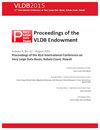DuckPGQ:将SQL/PGQ引入DuckDB
IF 3.3
3区 计算机科学
Q2 COMPUTER SCIENCE, INFORMATION SYSTEMS
引用次数: 0
摘要
我们展示了SQL:2023最重要的新特性,即SQL/PGQ,它通过引入模式匹配和(最短)寻径的新语法来简化使用SQL查询图。我们将展示如何使用一个名为DuckPGQ的扩展模块将SQL/PGQ支持集成到RDBMS中,特别是在DuckDB系统中。因此,我们还演示了DuckDB可扩展性机制的使用,该机制允许我们向DuckDB添加新的函数、数据类型、操作符、优化器规则、存储系统,甚至解析器。我们还描述了DuckPGQ模块所基于的新数据结构和算法,以及如何将它们注入SQL计划。虽然演示的DuckPGQ扩展模块是精简和高效的,但我们勾画了一个路线图:(i)通过新的算法(分解和WCOJ)和更好的并行性来提高其性能;(ii)将其功能扩展到SQL之外的场景,例如,构建和分析图神经网络。本文章由计算机程序翻译,如有差异,请以英文原文为准。
DuckPGQ: Bringing SQL/PGQ to DuckDB
We demonstrate the most important new feature of SQL:2023, namely SQL/PGQ, which eases querying graphs using SQL by introducing new syntax for pattern matching and (shortest) path-finding. We show how support for SQL/PGQ can be integrated into an RDBMS, specifically in the DuckDB system, using an extension module called DuckPGQ. As such, we also demonstrate the use of the DuckDB extensibility mechanism, which allows us to add new functions, data types, operators, optimizer rules, storage systems, and even parsers to DuckDB. We also describe the new data structures and algorithms that the DuckPGQ module is based on, and how they are injected into SQL plans. While the demonstrated DuckPGQ extension module is lean and efficient, we sketch a roadmap to (i) improve its performance through new algorithms (factorized and WCOJ) and better parallelism and (ii) extend its functionality to scenarios beyond SQL, e.g., building and analyzing Graph Neural Networks.
求助全文
通过发布文献求助,成功后即可免费获取论文全文。
去求助
来源期刊

Proceedings of the Vldb Endowment
Computer Science-General Computer Science
CiteScore
7.70
自引率
0.00%
发文量
95
期刊介绍:
The Proceedings of the VLDB (PVLDB) welcomes original research papers on a broad range of research topics related to all aspects of data management, where systems issues play a significant role, such as data management system technology and information management infrastructures, including their very large scale of experimentation, novel architectures, and demanding applications as well as their underpinning theory. The scope of a submission for PVLDB is also described by the subject areas given below. Moreover, the scope of PVLDB is restricted to scientific areas that are covered by the combined expertise on the submission’s topic of the journal’s editorial board. Finally, the submission’s contributions should build on work already published in data management outlets, e.g., PVLDB, VLDBJ, ACM SIGMOD, IEEE ICDE, EDBT, ACM TODS, IEEE TKDE, and go beyond a syntactic citation.
 求助内容:
求助内容: 应助结果提醒方式:
应助结果提醒方式:


